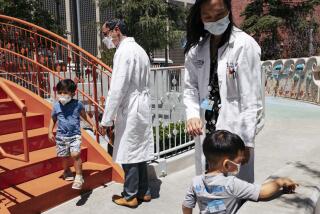How to Tell When They’re Too Sick to Go to School
- Share via
Your child wakes up feeling ill. Is it serious enough to call for a sick day, or should your child tough it out at school?
While each case is different, here are some guidelines from Dr. Robert Adler, head of general pediatrics, Childrens Hospital Los Angeles, and vice chairman of pediatrics, USC School of Medicine:
* If body temperature is 100 degrees Fahrenheit or below, there’s probably little cause for concern unless the child is at the beginning stages of an illness. Watch temperature for a few hours if possible.
* If fever is 100-104, keep the child home, give acetaminophen and consider calling the doctor.
* If fever is 104 or above, keep the child home and call the doctor.
* A child who is vomiting or has diarrhea should stay home.
* If a child is sniffling but otherwise feels well, does not have a temperature and does not have symptoms such as coughing or a rash, it’s probably OK to send him or her to school (although school policy might discourage it). It could be allergies, not a cold.
* For skin rashes, try to track down the trigger. If it’s the result of something the child came into contact with, such as a detergent that produces sensitivity, it’s obviously not infectious. But a skin rash accompanied by a stomachache could point to a viral illness that might be contagious. Skin rashes could also signal the beginning of chicken pox.






